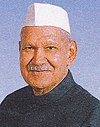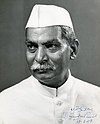President of India List from 1950 to 2023
Dr. Rajendra Prasad was the first president of India while Droupadi Murmu is the current president of India. The chronological sequence of the presidents of India is given in the table below. Check the list of presidents of India from 1950 to 2023.
| Name | Starting date | Ending date | Profiles |
| 1. Dr. Rajendra Prasad | January 26th, 1950 | May 13th, 1962 | He was the first President of republic of India. |
| 2. Dr. Sarvepalli Radhakrishnan | May 13th, 1962 | May 13th, 1967 | He was the 2nd President of India. |
| 3. Dr.the Zakir Hussain | May 13th, 1967 | May 3rd, 1969 | He was the 3rd President of India. |
| 4. Varahagiri Venkata Giri | May 3rd, 1969 | July 20th, 1969 | He was acting President because of Hussain’s death. |
| 5. Mohammad Hidayatullah | July 20th, 1969 | August 24th, 1969 | He was acting President till Giri’s presidency. |
| 6. Varahagiri Venkata Giri | August 24th, 1969 | August 24th, 1974 | He was the 4th President of India. |
| 7. Fakhruddin Ali Ahmed | August 24th, 1974 | February 11th, 1977 | He was the 5th President of India. |
| 8. Basappa Danappa Jatti | February 11th, 1977 | July 25th, 1977 | He was a chief minister of the Mysore but got elected as President, After the death of Ahmed. |
| 9. Neelam Sanjiva Reddy | July 25th, 1977 | July 25th, 1982 | Reddy was the 6th President of India unopposed. |
| 10. Giani Zail Singh | July 25th, 1982 | July 25th, 1987 | He was the 7th President of India and was also a member of the Congress party. |
| 11. Ramaswamy Venkataraman | July 25th, 1987 | July 25th, 1992 | He was the 8th President of India. He was also a lawyer and a professional politician. |
| 12. Shankar Dayal Sharma | July 25th, 1992 | July 25th, 1997 | He was the 9th President of India, and he was also a member of the National Congress party of India. |
| 13. Kocheril Raman Narayanan | July 25th, 1997 | July 25th, 2002 | He was the 10th President of India and the best diplomat in India. |
| 14. Dr. A.P.J. Abdul Kalam | July 25th, 2002 | July 25th, 2007 | He was the 11th President of India, and he was a great scientist. He worked in ISRO and DRDO organizations. |
| 15. Pratibha Patil | July 25th, 2007 | July 25th, 2012 | She was the 12th President of India, and she was the first woman to Be President. |
| 16. Pranab Mukherjee | July 25th, 2012 | July 25th, 2017 | He was the 13th President of India, and he was also a senior leader of the National Congress party. |
| 17. Shri Ram Nath Kovind | July 25th, 2017 | July 21st, 2022 | He is the 14th President of India, and he is also ex-governor Of Bihar. |
| 18. Droupadi Murmu | July 21st, 2022 | Working | She is the 15th President of India and was a member of the Bharatiya Janata Party |
Droupadi Murmu Became the New President of India
Droupadi Murmu has become the new president of India after the announcement of the result of the presidential elections on 21st July 2022. Droupadi Murmu is the 2nd women President of India and the first tribal woman President of India. Droupadi Murmu is the 15th President of India, after Shri Ram Nath Kovind. The candidate of the ruling Bharatiya Janata Party (BJP), the 64-year-old former teacher comes from Odisha (Orissa) state and has had a stint as a state governor.
List of Presidents of India
A detailed discussion of the list of Presidents of India is given below.
15) Droupadi Murmu (2022-Incumbent)
Droupadi Murmu is the current president of the Republic of India elected on 21st July 2022. She is the 15th President of India after Shri Ram Nath Kovind. Murmu joined the Bharatiya Janata Party (BJP) in 1997 and was elected as the councillor of the Rairangpur Nagar Panchayat. Murmu became the Chairperson of Rairangpur Nagar Panchayat in 2000. She also served as the national vice-president of BJP Scheduled Tribes Morcha. Murmu was the first woman Governor of Jharkhand. Check below the list of the Presidents preceding her.
14) Shri Ram Nath Kovind (2017-2022)
Shri Ram Nath Kovind is an Indian politician who served as the 14th President of India from 25 July 2017 to 21st July 2022. He was the first person from Uttar Pradesh to serve as President of India. Ram Nath Kovind was the former Governor of Bihar. He has been an ardent champion of equality in society and integrity in public life.
13) Pranab Mukherjee (2012-2017)
Pranab Mukherjee was an Indian politician and government official who served as the 13th President of India from 2012 to 2017). Pranab Mukherjee died on 31 August 2020, at the age of 84, after battling a long illness. A veteran in Indian politics, he had the rare distinction of having served as Foreign, Defence, Commerce and Finance Minister at different times over his long and illustrious political career spanning several decades.
12) Pratibha Patil (2007-2012)
Pratibha Patil was the first woman to serve as president of India. She was the 12th President of India and served from the year 2007 to 2012. Prior to her election as president, Patil served as the governor of Rajasthan from 2004 to 2007, the first woman to hold this office as well. While in the Rajya Sabha, Patil was the deputy chairperson from 1986 to 1988 and also served as the chairperson when Dr. R. Venkataraman was elected as President of India.
11) Dr. A.P.J. Abdul Kalam (2002-2007)
Avul Pakir Jainulabdeen Abdul Kalam was an Indian aerospace scientist who served as the 11th President of India from 2002 to 2007. A.P.J. Abdul Kalam, in full Avul Pakir Jainulabdeen Abdul Kalam, (born October 15, 1931, Rameswaram, India—died July 27, 2015, Shillong), Indian scientist and politician who played a leading role in the development of India’s missile and nuclear weapons programs.
10) Kocheril Raman Narayanan (1997-2002)
Kocheril Raman Narayanan was a member of Parliament from the Ottapalam constituency for three successive tenures (1984, 1989 and 1991). In 1985, he was appointed as the Minister for State (Planning, External Affairs and Science and Technology) in the Rajiv Gandhi government. In 1992, he was elected as the Vice-President of India and subsequently, in 1997, he was elected to the highest office of the President of India. He was the first Dalit to hold the high office of the President of India as 10th President of India.
9) Shankar Dayal Sharma (1992-1997)
Shankar Dayal Sharma was 9th President of India and served the nation from 1992 to 1997. He was Chief Minister of the erstwhile Bhopal State (April 1 952 to November 1956), Cabinet Minister, Government of Madhya Pradesh holding the portfolios of Education, Law, Public Works, Industry and Commerce, National Resources and Separate Revenue (1950-1 967) and was thereafter Union Minister for Communications (10th October 1974 to 24th March 1977). He was Governor of Andhra Pradesh (29th August 1 984 to 25th November 1985) and Governor of Punjab (26th November 1985 to 2nd April 1986).
8) Ramaswamy Venkataraman (1987-1992)
Earlier a freedom struggle, he became the 8th President of India in 1987. His duration as President of India ends in 1992. He received Tamra Patra from India and Soviet Land Prize from Russia for his works.
7) Giani Zail Singh (1982-1987)
The Chief Minister of Punjab became India’s President in 1982. His tenure of 5 years brought red-letter days like Indira Gandhi’s assassination, Operation Blue Star, anti-Sikh riot etc.
6) Neelam Sanjeeva Reddy (1977-1982)
He was the first President to be elected unopposed. From the post of Lok Sabha Speaker, he became the president and remained so until 1982.
5) Fakhruddin Ali Ahmed (1974-1977)
After Hussain, he became the second President to die while still in post. He acted as the president for a tenure of 3 years, from 1974 to 1977.
4) Varahagiri Venkata Giri (1969-1974)
He remained the President from 1969 to 1974. He was the only independent candidate to be the President of India. He was also awarded Bharat Ratna in 1975.
3) Dr Zakir Hussain (1967-1969)
The first Muslim President of India Dr Husain served a tenure of 2 years up to 1969 and died at the post. After his death, Mohammad Hidayatullah was made acting president. Earlier Dr Husain was the Governor of Bihar.
2) Dr Sarvepalli Radhakrishnan (1962-1967)
The man whose birthday is observed and celebrated as the Teachers’ Day was the second President of India. His tenure was from 1962 to 1967. In 1954 Bharat Ratna was awarded to him.
1) Dr Rajendra Prasad (1950-1962)
The
first President of India, Dr Prasad worked for two consecutive terms
from 1950 to 1962. Indian Independence Movement was led by him and he
headed the Constituent Assembly. In 1962 he was awarded the Bharat
Ratna.















Comments
Post a Comment